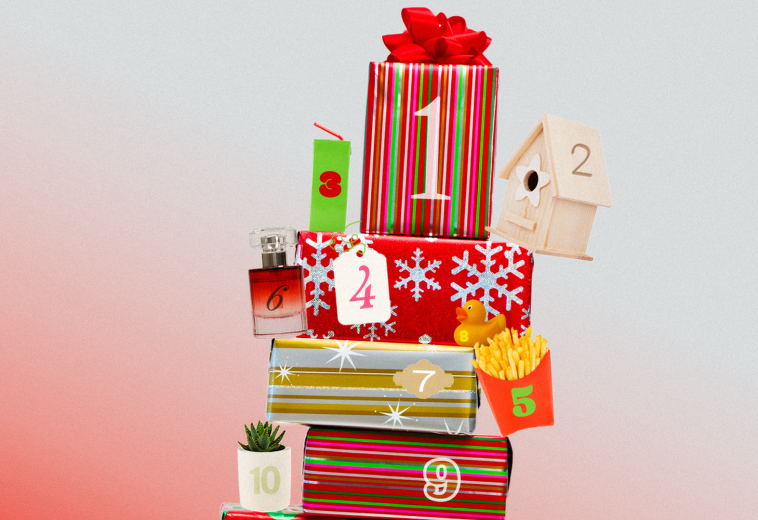In September, much of the country was still sweltering in the summer heat. But on TikTok, the holiday season had begun. That month, influencers began to post unboxing videos of advent calendars, revealing 25 little samples of skincare, stationery, candy, and more.
If you’re flummoxed by how early in the year we’re seeing this type of content, you’re not alone.
“Why are advent calendars ALREADY coming out?” a commenter posted on an influencer’s viral unboxing of an Anthropologie beauty set on September 23.
Traditionally, advent calendars were a fun but low-key holiday gimmick. Each day, you open a new section of the calendar as you countdown to Christmas, and there’s usually a piece of chocolate or candy inside. But now, it seems everyone has their own version and they’re getting more and more over the top. This year—in addition to the dozens of beauty and skincare versions that have been cropping up—we saw advent calendars from Netflix, reiki crystal healers, and even dog food brands.
Why have advent calendars become such a craze? Marketing experts told Glamour that it’s pretty simple: they serve as brilliant branding tools. While many companies may not yield a significant return on investment, the calendar serves as a fun, cheeky way to engage their most loyal customers and to acquire new ones who want to dip a toe into their products. After all, who doesn’t love unboxing?
Leigh Sevin, the founder of the retail marketing company Endear, tells Glamour that the trend of brands creating advent calendars specifically to drive sales is pretty new. But, she says, it makes a lot of sense.
“They [offer] a gifting experience that can become recurring purchases,” she says. For example, Sevin says she’s a “huge fan of Glossier” and thinks she’d buy an advent calendar from the beauty company so she could try their other products.
Joep Leussink, the head of marketing for AddEvent, a calendar and event tool, added that advent calendars are also sneaky tools for companies to test how well their products will be received. “The benefit of an advent calendar is you can promote multiple products and have tests or B2B trials that you can really explore,” he says.
Plus, the calendars’ stunty and fun nature are inherently engaging for content. The more influencers that companies send their products to, the more likely their advent calendars are to go viral.
“Each time you encounter the advent calendar the brand is associated with a positive experience,” says Anthony Miyazaki, a professor of marketing at Florida International University.
He adds that through embracing the trend, a company has 25 days to engender feelings of excitement or holiday joy with consumers.
“The brand gets ongoing feel-good exposure,” he says.
Original video by Glamour commerce director Brie Schwartz
Original video by Glamour commerce director Brie Schwartz
Many influencers agree with brands: advent calendars are good content. Some are even buying these calendars (yes, with their own money) because they know it will generate engagement to their accounts. Zahava Ben-Haim, a full-time TikToker based in New Jersey, tells Glamour she also noticed how early advent calendars were being released this year, and she jumped on the trend to serve her audience.
“I’m buying [them] from the brand’s site and I try to have a review live within a few days of when the launch was announced,” said Ben-Haim. “That way my audience is still interested and the hype for the cal is still at its peak.”
Searches for niche advent calendars have also been on the steady rise over the last few years, according to marketing strategists Courtney Mulock and Mary Chambers. They said in a statement to Glamour that interest in beauty advent calendars has grown steadily over the years, with searches climbing in 2022 and 2023.
Over the past three months, they said, searches for “perfume advent calendar” skyrocketed by over 1,288%, “with ‘men’s fragrance advent calendar,” “Korean skincare advent calendar,” and “haircare advent calendar” all seeing triple-digit growth.
But brands beware: if an advent calendar does not live up to its hype, it could become a PR problem. Earlier in the year, when Sephora unveiled its much-anticipated advent calendar, the product went viral for all the wrong reasons. TikTokers who spent their own Sephora Beauty Insider points (2,500 to be exact) opened up what they felt were basic and undesirable products —like hair clips and scrunchies—and were outraged. In 2021, Chanel infamously drew backlash for their $825 calendar that offered stickers and a paperweight. The luxury brand has not released an advent calendar since.
“Attention to detail and respect for the consumer relationship are non-negotiable,” said Mulock and Chambers. “In a category where excitement, anticipation, and perceived value are everything, brands that fall short risk losing far more than a sale— they risk their reputation. Advent calendars are no exception.”
It’s worth a try, though. If done right (like this massive Alo Yoga one that received rave reviews from TikTokers) it is marketing magic. A brand gets a gold star in press and consumer feedback and the product can become engaging videos on social media, sometimes even organically. It’s a holiday win-win.





GIPHY App Key not set. Please check settings